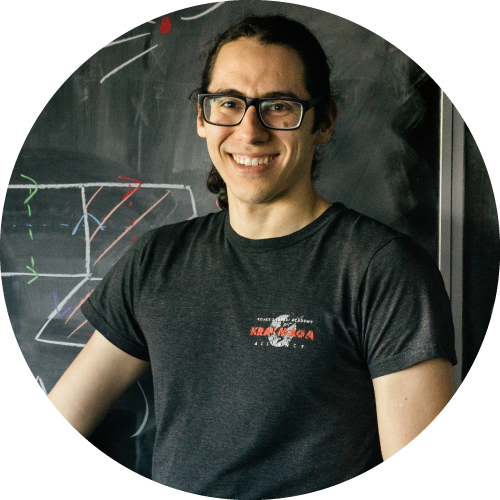Name:
Jacob Russell
Department:
Project Title:
Convexity in Hierarchically Hyperbolic Spaces
Website:
Jacob Russell is a fifth year PhD student in the Department of Mathematics at The Graduate Center. He received his BA in Mathematics from California State University, Sacramento in 2014. His research interests lie in geometric group theory, which aims to better understand algebraic ideas, by reinterpreting them as symmetries of geometric objects.
Project
High school geometry focuses on studying lines, circles, triangles and squares in the coordinate plane. The usefulness of the plane as a model for reality hinges upon our ability to understand the properties of these basic geometric figures. Despite the differences between them, lines, circles, triangles, and squares are all examples of convex sets in the plane. While the plane is the most famous geometric model, mathematics contains an ever growing array of geometric models to describe the diverse phenomena we encounter in our universe. Just as in the plane, understanding these more unfamiliar geometric models often boils down to understanding their convex sets. In this project, we produce some of the foundational work in a newly induced category of geometric models called hierarchically hyperbolic spaces by exploring many of the characteristics of their convex sets. This is joint work with Hung C. Tran from the University of Georgia and Davide Spriano from ETH Zürich.
High school students everywhere spend countless hours laboring over the coordinate plane. This humble object is the simplest example of a geometric model: an abstraction which assists us in studying and understanding our world. Flexible yet powerful, the plane models situations ranging from classical mechanics in physics, to the dynamics of supply and demand in economics, to the population trajectory of grizzlies in Yellowstone National Park.
Despite the plane’s ubiquity, it is far from the only geometric model useful for describing our universe. For example, if you are trying to determine the most efficient route for a flight from San Francisco to London, you will be much better off modeling the Earth as a round sphere than as a flat plane. With the ever growing diversity of phenomena we encounter in our universe, mathematicians are constantly working to both create and understand new geometric models.
My mathematics research focuses upon studying a class of geometric models called hierarchically hyperbolic spaces (HHSs). The philosophy of HHSs is that they model situations where geometric information can be obtained by looking the projections or shadows. As a non-technical example of this philosophy, consider the problem of trying to determine the shape of the Earth without space flight. Earth-bound humans may not be able to see the entire planet directly, but they can observe the shadow of the Earth on the moon. From this projection of the Earth onto the moon, we can see that the Earth must be round.
The usefulness of the plane as a geometric model boils down to how well we can understand fundamental geometric objects such as lines, circles, and polygons (triangles, squares, hexagons, etc). Appropriately, the majority of high school geometry is spent studying the properties of these basic figures. One of the reasons these basic objects are so important is that they are all convex; a geometric object in the plane is convex if the line connecting any two points in the figure stays inside the figure. Just as is the case with the plane, understanding more exotic geometric model hinges upon understanding the convex objects in the model. In many ways, the study of geometry is really the study of convexity.
Hierarchically hyperbolic spaces are a new class of geometric models and many of the fundamental features and properties are still poorly understood to geometers. In joint work with Davide Spriano (ETH Zürich) and Hung C. Tran (University of Georgia), we produce some of the foundational work on HHS’s by studying their convex objects. The main result of our study is to understand how you can use projections to “see” whether or not an object in a hierarchically hyperbolic space is convex. This allows us to paint a clear picture of the properties and characteristics of convex objects in hierarchically hyperbolic spaces.






